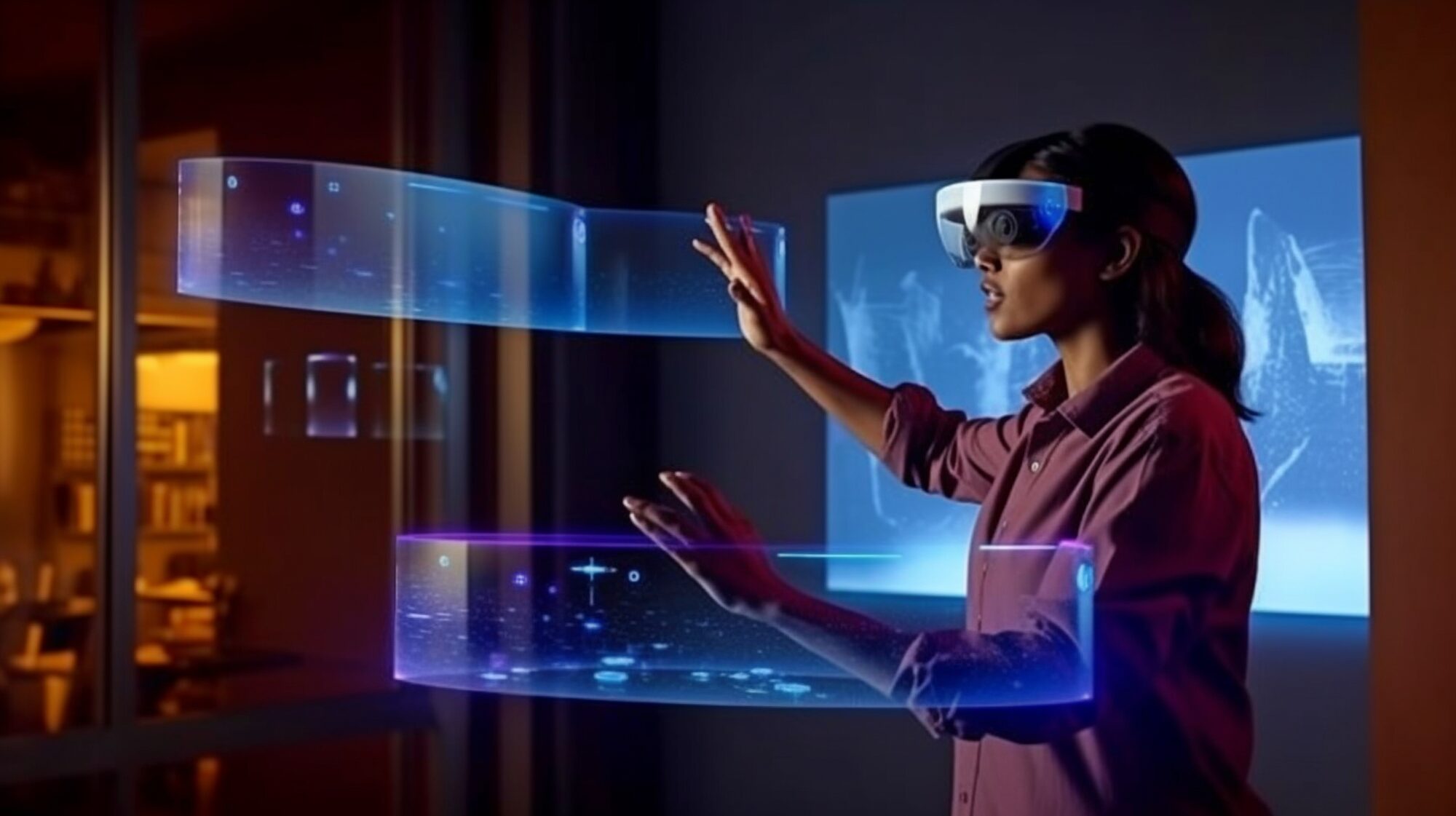The world is changing and the educational landscape is no exception. Technology is revolutionizing traditional teaching methods and enhancing the learning experience for students.
Augmented reality in education
Augmented reality (AR), a technology that overlays digital content onto the real-world environment, has emerged as a powerful tool in education. By blending virtual elements with the physical world, augmented reality in learning offers a myriad of benefits that transform the way students engage with educational content. In this article, we will explore the 9 benefits of augmented reality in education, shedding light on its potential to enhance interactive learning, boost student engagement, and improve knowledge retention.
Augmented reality (AR) revolutionizes traditional education by offering enhanced interactive learning experiences. Unlike passive learning methods, AR enables students to actively engage with the subject matter through immersive and interactive elements. For example, in science classes, AR can bring complex scientific concepts to life by allowing students to visualize three-dimensional models of molecules or explore virtual environments simulating scientific phenomena. This hands-on approach fosters curiosity, encourages exploration, and enables students to interact with the subject matter in a tangible and meaningful way. AR also promotes collaborative learning, as students can engage in group activities where they work together to solve problems or complete virtual simulations. This interactive nature of AR in education not only enhances student engagement but also deepens their understanding and retention of knowledge.
The benefits of augmented reality for education include but are not limited to the following advantages.
Enhanced interactive learning
Traditional classroom settings often rely on passive learning methods, leaving students craving for more engaging and interactive experiences. Augmented reality, however, brings a dynamic shift to the educational landscape by offering enhanced interactive learning opportunities. Through the integration of virtual elements, AR enables students to actively engage with the subject matter, turning abstract concepts into tangible experiences. For instance, in science classes, AR can bring complex scientific phenomena to life by allowing students to visualize three-dimensional models or conduct virtual experiments.
By manipulating and interacting with virtual objects in a hands-on manner, students gain a deeper understanding of the subject matter, fostering curiosity, critical thinking, and problem-solving skills. The immersive and interactive nature of AR not only captivates students’ interest but also encourages collaboration, as they can engage in group activities and simulations, working together to explore and solve challenges. Through enhanced interactive learning experiences, augmented reality empowers students to become active participants in their own education, paving the way for deeper comprehension and knowledge acquisition.
Increased student engagement
One of the key benefits of augmented reality in education is its ability to significantly increase student engagement. Traditional lectures and textbooks can sometimes fail to capture students’ attention and result in passive learning experiences. However, augmented reality for learning transforms the process by creating an exciting and interactive environment that captivates students’ interest. By overlaying digital content onto the real world, AR brings subjects to life, making learning more fun and engaging.
For example, history lessons can be enriched with AR by allowing students to explore historical landmarks virtually or witness important events unfold in a 360-degree immersive experience. This level of engagement and interactivity not only motivates students but also facilitates deeper comprehension and long-term retention of the material. AR’s ability to bridge the gap between the physical and digital worlds unlocks a new dimension of learning possibilities, empowering students to actively participate and take ownership of their educational journey.
Improved knowledge retention
Augmented reality in education offers a promising solution to the challenge of knowledge retention. Traditional teaching methods often struggle to ensure long-term retention of information, as students may struggle to connect abstract concepts to real-world applications. However, AR provides a multisensory learning experience that enhances memory retention and recall.
By visualizing complex ideas through interactive and contextualized virtual elements, AR helps students form stronger mental connections and associations with the subject matter. Research has shown that the combination of visual and auditory stimuli in AR significantly improves information recall compared to traditional methods. When students can see and interact with virtual objects related to the content they are studying, they are more likely to retain that knowledge over time. By leveraging the power of AR, educators can empower students to retain information more effectively and build a solid foundation of understanding that extends beyond the classroom.
Enhanced interactive learning
By integrating virtual elements into the real world, AR enables students to actively engage with the subject matter, turning abstract concepts into tangible experiences. Through hands-on interactions with virtual objects and immersive simulations, students can deepen their understanding, foster critical thinking, and develop problem-solving skills. This interactive approach sparks curiosity and encourages collaboration, creating a dynamic learning environment that motivates and empowers students.

presentation to try
Nsflow in action
Personalized learning
Augmented reality allows for personalized learning experiences tailored to individual student needs. By adapting content and interactions based on a student’s progress and abilities, AR can provide targeted support and challenges. Through adaptive feedback and customized virtual scenarios, AR can cater to different learning styles, pace, and preferences. This personalized approach enhances student engagement and comprehension, leading to more effective learning outcomes.
Real-world application
One of the remarkable benefits of AR in education is its ability to bridge the gap between classroom learning and real-world application. AR enables students to connect theoretical knowledge to practical scenarios by overlaying virtual elements onto real-world environments. Whether it’s exploring architecture through virtual building design or practicing medical procedures on virtual patients, AR immerses students in authentic experiences, preparing them for future careers and real-life challenges.
Accessibility and inclusivity
Augmented reality in education promotes inclusivity by offering accessibility features and accommodating diverse learner needs. AR can provide audio cues, visual aids, and multi-sensory feedback, supporting students with different learning abilities or disabilities. By removing physical barriers and providing alternative ways to interact with content, AR ensures that all students can actively participate and benefit from the learning experience. This inclusive approach fosters a positive and empowering learning environment for all learners.
Global and cultural perspectives
Augmented reality transcends geographical boundaries, offering students access to global and cultural perspectives. Through virtual travel experiences, language translations, or interactive cultural exhibitions, AR allows students to explore different countries, traditions, and languages without leaving the classroom. This exposure to diverse cultures fosters empathy, cultural awareness, and global citizenship, preparing students to thrive in a globalized world.
Gamification and motivation
Augmented reality has the potential to leverage gamification elements, transforming the learning experience into an engaging and motivating journey. By incorporating game-like features such as challenges, rewards, and progress tracking, AR can make learning enjoyable and encourage healthy competition among students. Gamification in education through AR promotes intrinsic motivation, as students are driven by the desire to achieve goals, earn badges, or unlock new levels. This gamified approach increases student motivation, persistence, and overall enjoyment of the learning process.
The takeaway
Augmented reality is transforming the educational landscape by providing enhanced interactive learning experiences, increasing student engagement, and improving knowledge retention. Through practical examples of augmented reality in education, it is evident that AR has the potential to revolutionize traditional education, making it more immersive, interactive, and effective. As educators embrace this technology and leverage its benefits, they have the opportunity to create engaging learning environments that prepare students for the challenges and opportunities of the future. By harnessing the power of AR for education, we can unlock a new era of schooling that fosters creativity, critical thinking, and lifelong learning.



















